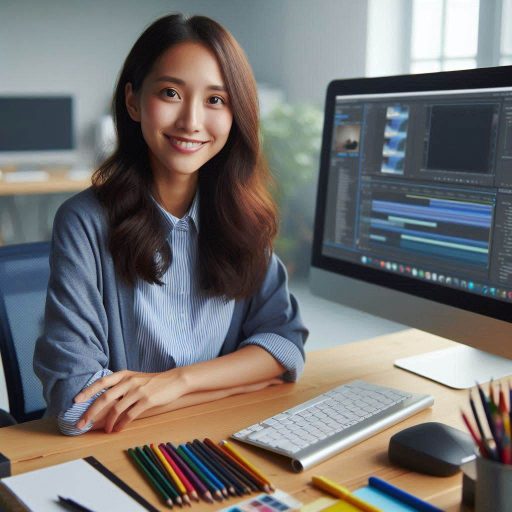Introduction
A multimedia art and design studio is a creative space that integrates various forms of media, such as digital, visual, and audio elements, to produce compelling artistic works.
These studios often blend traditional art with modern technology, allowing artists and designers to explore innovative ways of expression.
By combining different mediums, creators can generate unique projects that stand out in today‘s digital world.
Having a multimedia art and design studio offers numerous benefits.
First, it provides a versatile platform for creators to experiment with various tools and technologies.
This fosters innovation and opens doors to diverse creative possibilities.
Additionally, working in a multimedia environment allows collaboration between artists, designers, and technologists, encouraging cross-disciplinary creativity.
The studio also enhances productivity by centralizing all necessary tools and resources in one location.
This streamlines the creative process, making it easier to produce professional-quality work efficiently.
Furthermore, multimedia studios are highly adaptable, accommodating a wide range of projects, from graphic design to video production and animation.
Lastly, having access to cutting-edge equipment and software in a multimedia studio keeps creators competitive in an evolving industry.
It helps them stay up to date with emerging trends and technologies, ensuring their work remains relevant and engaging.
Overall, a multimedia art and design studio is an invaluable resource for any creative professional aiming to expand their artistic horizons.
Setting Up Your Workspace
Creating a multimedia art and design studio requires careful planning and consideration, especially when it comes to setting up your workspace.
Your workspace is where all the magic will happen, so it’s important to create a functional and inspiring environment that will help you unleash your creativity and produce amazing work.
Here are some tips on how to set up your workspace for success:
Choose a Location with Enough Space
When selecting a location for your studio, make sure you have enough room to accommodate all your equipment, tools, and materials.
You’ll need space for your computer, drawing tablet, printer, scanner, and any other devices you use for your projects.
Having enough physical space will allow you to move freely and work comfortably without feeling cramped or cluttered.
Invest in Quality Lighting and Sound Systems
Good lighting is essential for creating art and design work, so invest in quality lighting fixtures that provide ample light without causing glare or shadows.
Transform Your Career Today
Unlock a personalized career strategy that drives real results. Get tailored advice and a roadmap designed just for you.
Start NowConsider natural light options like windows or skylights to brighten up your space and reduce eye strain.
Additionally, a sound system can help set the mood in your studio and keep you motivated while you work.
Choose speakers that deliver high-quality sound for music, podcasts, or other forms of audio inspiration.
Organize Your Tools and Materials for Easy Access
Keeping your tools and materials organized is key to a productive workspace.
Utilize storage solutions like shelving units, drawers, and containers to keep everything tidy and easily accessible.
Consider labeling your supplies or creating designated areas for specific tools to streamline your workflow and minimize time spent searching for what you need.
A clean and organized workspace will not only boost your efficiency but also enhance your overall creative process.
By following these tips and setting up your workspace with care and consideration, you’ll create an environment that fosters creativity, productivity, and inspiration.
Remember, your studio is where your ideas come to life, so make sure it’s a space that reflects your unique style and vision.
Read: Costume Design Trends for 2024
Choosing the Right Equipment
Research and invest in high-quality cameras, microphones, and editing software
When setting up a multimedia art and design studio, it is essential to have the right equipment to produce high-quality content.
Researching and investing in top-notch cameras, microphones, and editing software will make a significant difference in the final product.
High-quality equipment will not only enhance the visual and audio quality of your work but also make the editing process more efficient and effective.
Cameras
When choosing a camera for your studio, consider factors such as resolution, frame rate, sensor size, and lens compatibility.
Investing in a camera with 4K resolution or higher will ensure that your videos are crisp and clear.
Additionally, a camera with a high frame rate will allow you to capture smooth slow-motion footage.
Consider the type of projects you will be working on and choose a camera that meets those specific needs.
Microphones
Audio quality is just as important as video quality when it comes to multimedia content creation.
Invest in high-quality microphones that can capture clear and crisp audio.
Depending on your projects, you may need different types of microphones such as lavalier, shotgun, or condenser microphones.
Transform Your Career Today
Unlock a personalized career strategy that drives real results. Get tailored advice and a roadmap designed just for you.
Start NowConsider the environment in which you will be recording and choose a microphone that is suitable for that setting.
Editing Software
Editing software is where the magic happens in multimedia content creation.
Choose editing software that is user-friendly and has the features you need to bring your creative vision to life.
Popular editing software options include Adobe Premiere Pro, Final Cut Pro, and DaVinci Resolve.
Consider the learning curve of each software and choose one that best fits your skill level and workflow.
Consider the specific needs of your projects when selecting equipment
When choosing equipment for your multimedia art and design studio, it is crucial to consider the specific needs of your projects.
Different projects may require different types of equipment, so it is essential to have a diverse arsenal of tools at your disposal.
Consider the genre, style, and overall vision of your projects when selecting equipment to ensure that you have everything you need to bring your creative ideas to life.
Visual Projects
If you will be working on visual projects such as photography, videography, or animation, invest in high-quality cameras with a variety of lenses to capture different perspectives.
Consider the lighting conditions of your shooting locations and invest in lighting equipment to ensure that your visuals are well-lit and visually appealing.
Additionally, investing in a green screen can open up endless possibilities for creating visually stunning projects.
Audio Projects
For audio projects such as podcasting, music production, or voiceovers, invest in high-quality microphones that are suitable for recording clear and crisp audio.
Consider acoustic treatment for your recording space to minimize echo and background noise.
Additionally, invest in headphones and audio interfaces to ensure that you can monitor and edit your audio projects with precision.
Editing Projects
If you will be working on editing projects such as video editing, graphic design, or animation, choose editing software that has the features you need to bring your creative vision to life.
Invest in a powerful computer with sufficient RAM and storage to handle large files and complex projects.
Additionally, consider investing in additional peripherals such as graphic tablets or control surfaces to streamline your editing workflow.
Read: How to Land Your First Job in Multimedia Design

Hiring a Team
Determine the roles you need to fill in your studio
When building a multimedia art and design studio, it’s crucial to identify the specific roles you need to fill to ensure the successful operation of your business.
Start by assessing the scope of your projects and the tasks involved in each stage of production.
Transform Your Career Today
Unlock a personalized career strategy that drives real results. Get tailored advice and a roadmap designed just for you.
Start NowThis will help you determine the key positions that need to be filled to achieve your goals.
Consider the following roles commonly found in multimedia art and design studios:
- Art Director: Responsible for overseeing the visual aspects of the projects, ensuring they are cohesive and on-brand.
- Graphic Designer: Creates visual concepts and designs for various marketing materials, websites, and other digital platforms.
- Animator: Develops animations and visual effects for videos, games, and interactive media.
- Videographer: Captures and edits video footage for promotional videos, documentaries, and other multimedia projects.
- Web Developer: Builds and maintains websites to ensure they are functional, user-friendly, and visually appealing.
- UI/UX Designer: Focuses on improving user experience and interface design for websites, applications, and software.
- Marketing Specialist: Develops strategies to promote the studio’s work and attract new clients.
- Project Manager: Coordinates projects, manages timelines, and ensures deliverables are met on time and within budget.
Look for talented individuals with diverse skills in multimedia art and design
Once you have identified the roles you need to fill in your studio, it’s time to start looking for talented individuals who possess a diverse set of skills in multimedia art and design.
When hiring team members, look for individuals who not only have technical expertise but also possess creativity, passion, and the ability to think outside the box.
Consider the following tips when hiring team members for your multimedia art and design studio:
- Create detailed job descriptions outlining the responsibilities and qualifications required for each role.
- Utilize online job boards, social media platforms, and industry-specific websites to reach a wider pool of candidates.
- Network with other professionals in the industry and attend industry events to meet potential candidates.
- Conduct thorough interviews to assess candidates’ skills, experience, and fit with your studio’s culture.
- Consider hiring freelancers or contractors for specific projects to supplement your core team.
- Provide opportunities for professional development and ongoing training to help team members grow and advance in their careers.
By following these tips and guidelines, you can build a strong and talented team for your multimedia art and design studio that will help you bring your creative vision to life and achieve success in the industry.
Read: Collaborating in Multimedia Art Projects
Building a Portfolio
Showcase your best work on a professional website or social media
Having a strong online presence is crucial for artists and designers looking to grow their multimedia art and design studio.
Creating a professional website or utilizing social media platforms like Instagram or Behance can help showcase your portfolio to a wider audience.
Make sure to curate your portfolio carefully, selecting only your best work to feature.
This will help potential clients or collaborators get a sense of your style and capabilities.
Consider including a variety of projects to demonstrate your versatility and range.
Collaborate with other artists and designers to expand your portfolio
Collaborating with fellow artists and designers is a great way to not only expand your portfolio but also gain new perspectives and insights.
Working on joint projects allows you to showcase your ability to work collaboratively and can lead to exciting new opportunities.
Look for ways to connect with other creatives in your industry, whether through social media, networking events, or local art and design communities.
By collaborating with others, you can combine your unique strengths and skills to create innovative and impactful work that will impress potential clients and elevate your studio’s reputation.
Read: Day in the Life of a Costume Designer
Gain More Insights: The Future of Creative Directing in Digital Media
Marketing Your Studio
Develop a branding strategy that reflects your studio’s unique style
Creating a strong brand identity is crucial for attracting clients and standing out in the competitive art and design industry.
Consider what sets your studio apart from others and use that to create a distinct brand that resonates with your target audience.
Transform Your Career Today
Unlock a personalized career strategy that drives real results. Get tailored advice and a roadmap designed just for you.
Start NowThis could include developing a unique logo, color scheme, and visual aesthetic that reflects your studio’s creative vision.
Consistency is key, so make sure your branding is cohesive across all platforms, from your website to your social media profiles.
Utilize social media and networking events to promote your studio
Social media is a powerful tool for reaching a wider audience and engaging with potential clients.
Create profiles on popular platforms like Instagram, Facebook, and Pinterest to showcase your work, share behind-the-scenes glimpses of your creative process, and connect with followers.
Regularly post updates, promotions, and interactive content to keep your audience engaged and attract new clients.
Additionally, attending networking events like art fairs, conferences, and workshops can help you establish valuable connections within the industry and promote your studio to a larger community.
Maintaining Your Studio
Regularly update and upgrade your equipment to stay current
Keeping your multimedia art and design studio up to date with the latest equipment is essential for producing high-quality work.
As technology advances, so should your tools to ensure you are able to meet the demands of your clients and stay competitive in the industry.
Investing in new software, hardware, and gadgets can enhance your creative process and streamline your workflow.
Whether it’s a new camera, graphic tablet, or editing software, regularly upgrading your equipment will help you stay ahead of the curve and maintain a professional standard in your work.
Consider setting aside a budget for equipment upgrades each year to ensure you are always equipped with the best tools available.
Research new products on the market and read reviews to make informed decisions about what will best suit your needs and enhance your capabilities as an artist or designer.
Implement a schedule for cleaning and organizing your workspace
A clean and organized workspace is essential for productivity and creativity.
Clutter can be distracting and hinder your ability to focus on your work, so it’s important to establish a routine for cleaning and organizing your studio.
Set aside time each week or month to declutter and tidy up your workspace.
This includes organizing your files, clearing off your desk, and cleaning your equipment to ensure everything is in working order.
A well-organized studio will not only improve your workflow but also create a more inspiring and inviting environment for your creativity to flourish.
Invest in storage solutions such as shelving, bins, and drawers to keep your supplies and materials organized and easily accessible.
Labeling containers and arranging items by category will make it easier to find what you need when you’re in the middle of a project.
Additionally, regularly purging unused or outdated materials will help keep your studio clutter-free and maximize your space for creating.
Transform Your Career Today
Unlock a personalized career strategy that drives real results. Get tailored advice and a roadmap designed just for you.
Start NowBy regularly updating and upgrading your equipment and implementing a schedule for cleaning and organizing your workspace, you can maintain a productive and inspiring studio that supports your artistic vision and creativity.
Prioritizing the maintenance of your studio will not only benefit your work but also contribute to a more efficient and enjoyable creative process.
Conclusion
Creating a multimedia art and design studio requires careful planning and consideration of various factors.
It is essential to have a clear vision and goals for your studio, as well as the necessary equipment and software.
Building a strong portfolio and establishing a strong online presence are also crucial for attracting clients and increasing visibility.
Networking with other artists and designers can provide valuable opportunities for collaboration and growth.
Additionally, continuing education and staying current with the latest trends and technologies in the field will help you stay competitive and relevant in the industry.
Lastly, don’t forget to have fun and stay inspired by exploring new ideas and experimenting with different techniques.
As you embark on this exciting journey of creating your own multimedia art and design studio, remember to stay patient and persistent.
With dedication and hard work, you can turn your passion for art and design into a successful and thriving business.
Take the next steps in setting up your own studio and make your creative dreams a reality!




